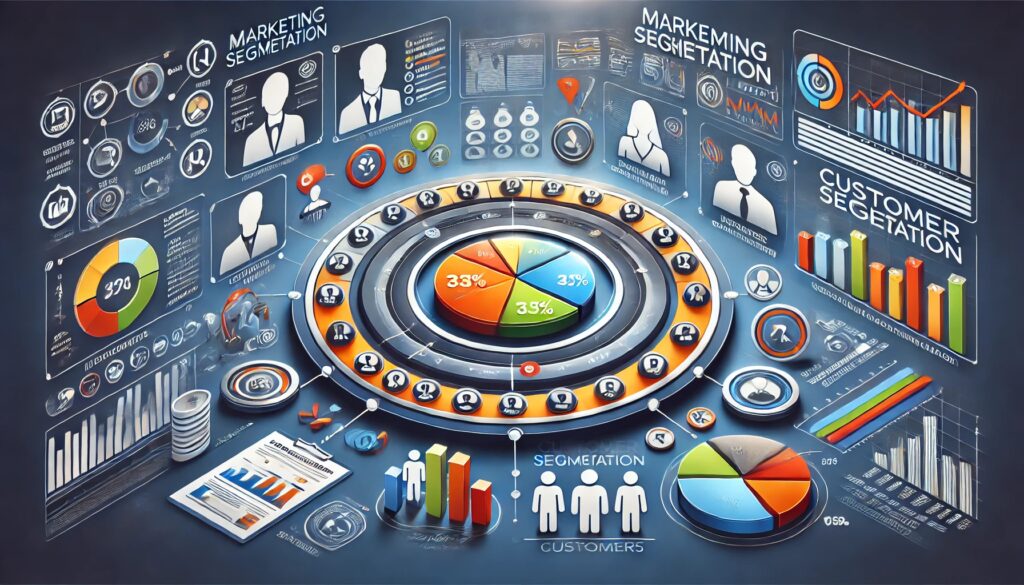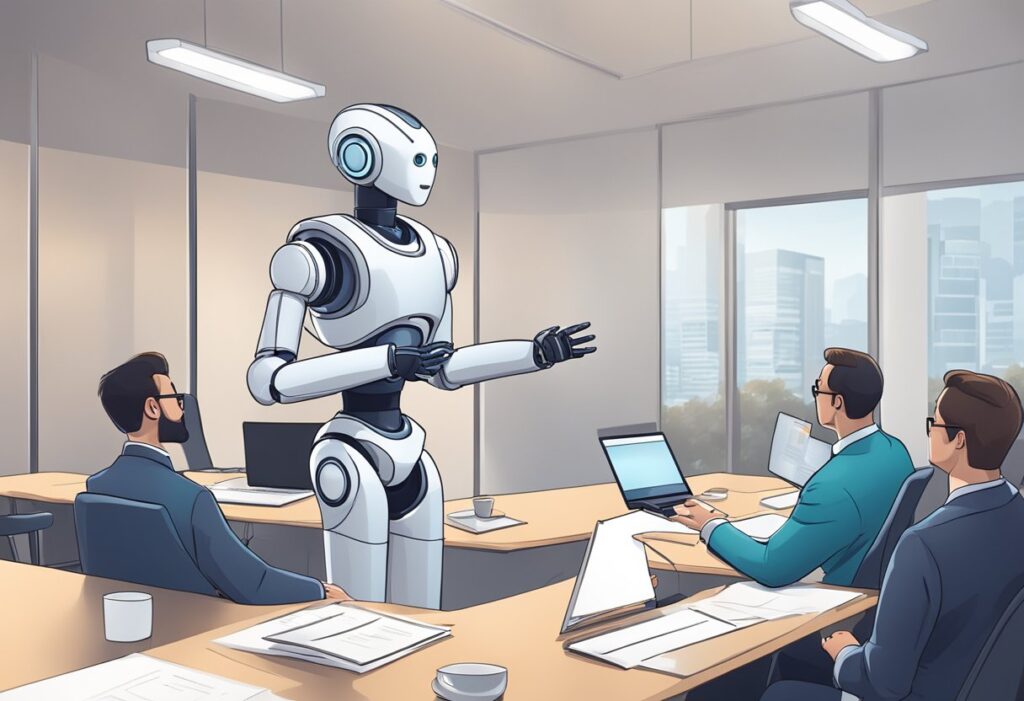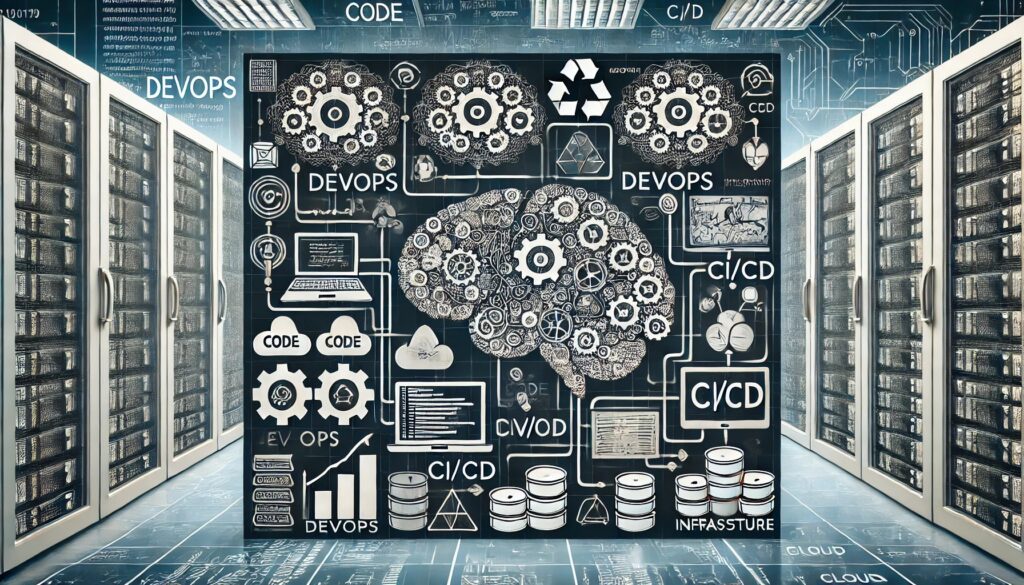AI in Business: Transforming HR and Employee Retention
Artificial Intelligence (AI) is revolutionizing how businesses operate, especially in Human Resources (HR) and employee retention. This comprehensive guide explores how AI is reshaping these critical areas, offering insights, benefits, and future trends.

I. Introduction
A. Definition of AI in Business
- Artificial Intelligence (AI) refers to the simulation of human intelligence in machines that are programmed to think like humans and mimic their actions.
- In the business context, AI involves using algorithms and software to analyze data, predict outcomes, and automate processes.
B. Importance of AI in Modern Business Operations
- AI has become indispensable in today’s business landscape.
- It enhances efficiency, drives innovation, and provides a competitive edge.
- From automating routine tasks to offering deep insights through data analytics, AI is a game-changer.
C. Overview of AI Applications in HR and Employee Retention
- AI is particularly impactful in HR, where it is used for:
- Recruitment
- Performance management
- Employee retention
- By leveraging AI, companies can:
- Predict employee turnover
- Personalize engagement strategies
- Improve overall job satisfaction
D. Purpose and Structure of the Paper
- This article aims to provide a detailed overview of how AI is transforming HR and employee retention.
- We will explore:
- Historical background
- Technologies
- Applications
- Benefits
- Challenges
- Future trends
II. Historical Background
A. Evolution of AI in Business
- AI’s journey in business began in the 1950s.
- Early applications focused on basic automation and data processing.
- Over the decades, advancements in computing power and algorithms have expanded AI’s capabilities.
B. Early Applications of AI in HR
- Initial AI applications in HR were limited to basic data management and applicant tracking systems.
- As technology evolved, so did the sophistication of these tools, paving the way for more advanced AI solutions.
C. Development of AI Tools for Employee Retention
- AI tools specifically designed for employee retention emerged in the late 2000s.
- These tools analyze employee data to identify patterns and predict turnover, allowing HR to proactively address retention issues.
D. Milestones in AI-driven Retention Strategies
- Significant milestones include:
- Development of predictive analytics
- Sentiment analysis
- AI-driven feedback systems
- These innovations have revolutionized how companies approach employee retention.
III. AI Technologies in HR and Employee Retention
A. Machine Learning
1. Predictive Analytics for Retention
- Machine learning algorithms analyze historical employee data to predict which employees are at risk of leaving.
- These predictions help HR intervene early with targeted retention strategies.
2. Algorithms and Models Used
- Common algorithms include:
- Decision trees
- Neural networks
- Support vector machines
- These models are trained on large datasets to identify key factors contributing to employee attrition.
B. Natural Language Processing (NLP)
1. Sentiment Analysis
- NLP techniques analyze employee communications to gauge sentiment.
- This helps HR understand employee morale and identify potential issues before they escalate.
2. Chatbots for Employee Support
- AI-powered chatbots provide 24/7 support to employees, answering queries and offering assistance.
- This enhances the employee experience and reduces the workload on HR teams.
C. Data Analytics
1. Big Data in Employee Retention
- Big data analytics enables HR to analyze vast amounts of employee data to uncover trends and insights.
- This data-driven approach leads to more informed decision-making.
2. Metrics and KPIs Tracking
- AI tracks key performance indicators (KPIs) and metrics related to employee retention.
- These insights help HR measure the effectiveness of their retention strategies and make necessary adjustments.
D. AI-driven Surveys and Feedback Systems
1. Real-time Feedback Collection
- AI-powered survey tools collect real-time feedback from employees.
- This provides HR with instant insights into employee engagement and satisfaction levels.
2. Analysis of Employee Engagement
- Advanced analytics tools process this feedback to identify engagement trends and areas for improvement.
- This helps HR enhance the overall employee experience.
IV. Applications of AI in Employee Retention
A. Predictive Attrition Analysis
1. Identifying At-risk Employees
- AI algorithms analyze employee data to identify those at risk of leaving.
- This enables HR to take proactive measures.
2. Patterns and Trends Detection
- By detecting patterns and trends, AI helps HR understand the underlying causes of employee turnover.
- This allows the development of targeted retention strategies.
B. Personalized Employee Engagement
1. Tailored Communication Strategies
- AI enables personalized communication strategies.
- This ensures that employees receive relevant and timely information.
2. Customized Career Development Plans
- AI helps HR create personalized career development plans based on:
- Employees’ skills
- Interests
- Performance
- This boosts engagement and retention.
C. Performance Management
1. Continuous Performance Monitoring
- AI continuously monitors employee performance.
- This provides real-time feedback and insights to both employees and managers.
2. AI-driven Performance Feedback
- Automated feedback systems use AI to offer constructive feedback.
- This helps employees improve their performance and stay engaged.
D. Learning and Development
1. Personalized Learning Paths
- AI creates personalized learning paths for employees.
- This tailors training programs to their specific needs and career goals.
2. AI-driven Training Programs
- AI-powered training programs adapt to the learning pace and style of each employee.
- This enhances the effectiveness of training initiatives.
E. Well-being and Support
1. AI-powered Mental Health Support
- AI-driven mental health tools provide employees with resources and support.
- This promotes overall well-being.
2. Employee Assistance Programs
- AI enhances employee assistance programs by offering personalized support and resources.
- This improves employees’ mental and emotional health.
V. Benefits of AI in Employee Retention
A. Improved Employee Satisfaction
1. Personalized Engagement
- AI’s ability to personalize engagement strategies leads to higher employee satisfaction and loyalty.
2. Enhanced Support Systems
- AI-driven support systems provide employees with the assistance they need.
- This fosters a supportive work environment.
B. Reduced Turnover Rates
1. Early Identification of Issues
- AI identifies potential issues early.
- This allows HR to address them before they lead to turnover.
2. Proactive Retention Strategies
- Proactive retention strategies, guided by AI insights, significantly reduce employee turnover rates.
C. Cost Savings
1. Lower Recruitment and Training Costs
- By retaining more employees, companies save on recruitment and training costs associated with high turnover.
2. Reduced Operational Disruptions
- Lower turnover rates lead to reduced operational disruptions.
- This ensures smooth business operations.
D. Enhanced Productivity
1. Continuous Performance Improvement
- AI-driven performance monitoring and feedback lead to continuous improvement in employee performance.
2. Better Alignment with Organizational Goals
- AI helps align employee goals with organizational objectives.
- This enhances overall productivity and success.
VI. Challenges and Ethical Considerations
A. Data Privacy and Security
1. Handling Sensitive Employee Data
- AI systems must handle sensitive employee data with care.
- This ensures compliance with privacy regulations.
2. Compliance with Regulations (GDPR, CCPA)
- Companies must comply with regulations like GDPR and CCPA to protect employee data and avoid legal issues.
B. Bias and Fairness
1. Algorithmic Bias in Retention Strategies
- AI algorithms must be designed to avoid bias.
- This ensures fair treatment of all employees.
2. Ensuring Equitable Treatment
- HR must ensure that AI-driven retention strategies treat all employees equitably.
- This prevents the perpetuation of biases.
C. Transparency and Accountability
1. Explainability of AI Decisions
- AI decisions must be transparent and explainable.
- This ensures trust and accountability.
2. Legal and Ethical Implications
- Companies must consider the legal and ethical implications of using AI in HR.
- This ensures responsible usage.
D. Human-AI Collaboration
1. Balancing Automation and Human Touch
- Striking a balance between automation and the human touch is crucial for effective HR management.
2. Training HR Professionals
- HR professionals need training to work effectively with AI tools.
- This enables them to leverage AI’s full potential.
VII. Case Studies and Examples
A. Successful Implementation
1. Companies Leveraging AI for Retention
- Several companies have successfully implemented AI for retention.
- They have achieved significant improvements in:
- Employee satisfaction
- Retention rates
2. Outcomes and Benefits Observed
- These companies have observed numerous benefits, including:
- Lower turnover rates
- Higher employee engagement
- Cost savings
B. Lessons Learned
1. Challenges Faced
- Implementing AI in HR comes with challenges, including:
- Technical hurdles
- Ethical dilemmas
- Organizational obstacles
2. Strategies for Overcoming Obstacles
- Successful companies have developed strategies to overcome these challenges, including:
- Robust data governance
- Bias mitigation
- Continuous improvement
VIII. Future Trends and Directions
A. Emerging AI Technologies
1. AI and Blockchain Integration
- The integration of AI and blockchain promises enhanced data security and transparency in HR processes.
2. Advanced Predictive Analytics
- Advancements in predictive analytics will offer even deeper insights into employee behavior and retention.
B. The Future of Work
1. AI’s Impact on HR Roles
- AI will reshape HR roles, requiring professionals to:
- Develop new skills
- Adapt to changing responsibilities
2. Preparing for the Future Workforce
- Companies must prepare for the future workforce by:
- Investing in AI-driven tools
- Developing strategies to attract and retain top talent
C. Continuous Improvement
1. Ongoing Innovation in AI for Retention
- AI-driven retention strategies will continue to evolve, driven by ongoing innovation and technological advancements.
2. Adapting to Changing Business Needs
- Companies must remain flexible and adapt their AI strategies to:
- Meet changing business needs
- Address workforce dynamics
IX. Conclusion
A. Summary of Key Points
- AI is transforming HR and employee retention.
- It offers numerous benefits, including:
- Improved satisfaction
- Reduced turnover
- Cost savings
B. The Transformative Potential of AI in HR and Employee Retention
- The transformative potential of AI in HR and employee retention is immense.
- AI promises a future where companies can:
- Proactively address retention issues
- Foster a more engaged workforce
C. Final Thoughts and Recommendations
- Companies should embrace AI in HR and employee retention.
- Leveraging its capabilities can help them:
- Stay competitive
- Create a thriving workplace
Resources
Articles and Papers
- “How AI is Revolutionizing Employee Retention” – Forbes
- This article discusses how AI tools are being used to predict employee turnover and improve retention strategies.
- “Using AI for Employee Retention: A Review” – ResearchGate
- This academic paper reviews various AI methodologies applied to employee retention, analyzing their effectiveness and challenges.
- Access the paper
- “AI and Employee Retention: Predictive Analytics in HR” – HR Technologist
- The article explores how predictive analytics and AI are being used to enhance employee retention efforts.
Books
- “Predictive Analytics for Human Resources” by Jac Fitz-enz and John R. Mattox II
- This book provides insights into using predictive analytics, including AI techniques, for improving HR functions like employee retention.
- Find it on Amazon
- “Artificial Intelligence for HR: Use AI to Support and Develop a Successful Workforce” by Ben Eubanks
- This book offers practical advice on leveraging AI for various HR tasks, including strategies for employee retention.
- Find it on Amazon
Online Courses and Webinars
- Coursera: “AI in People Analytics” by Wharton School
- This course provides a comprehensive overview of how AI is used in people analytics, with applications in employee retention.
- Enroll here
- LinkedIn Learning: “People Analytics”
- This course covers the fundamentals of people analytics, including how AI can help in retaining employees.
- Enroll here
- Webinar: “AI for Employee Retention: Strategies and Tools” – AIHR
- This webinar discusses the latest AI trends in employee retention and provides practical tips for implementation.
Research Institutions and Industry Reports
- McKinsey & Company: “How AI Can Improve Employee Retention”
- This report highlights how AI technologies can enhance employee retention strategies by providing insights into employee behavior and engagement.
- Deloitte Insights: “AI in HR: Leveraging Predictive Analytics for Employee Retention”
- This report explores the applications of AI and predictive analytics in HR, with a focus on improving employee retention.
- Gartner: “Using AI to Improve Employee Retention”
- This report provides insights into the top AI use cases for improving employee retention and best practices for implementation.





